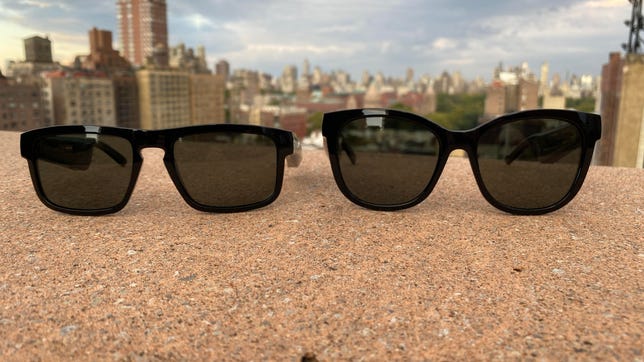Bose Frames 2020 review: These audio sunglasses rock
The Tempo, Tenor and Soprano versions cost $50 more than the previous Alto and Rondo models, but the boost in performance is worth it.

Pros
- Improved sound and battery life (up to 8 hours)
- Excellent voice calling capabilities (upgraded mics)
- Rock-solid wireless connection
- Larger speaker drivers than Tenor and Soprano (more bass)
- USB-C charging
- Water-resistant
Cons
- Fairly pricey
- Larger and bulkier than typical sports sunglasses
- Some sound leaks
Pros
- Upgraded design from Alto and Rondo (glossy finish)
- Improved sound and battery life (up to 5.5 hours)
- Excellent voice calling capabilities (upgraded mics)
- Rock-solid wireless connection
Cons
- Fairly pricey
- Little bulkier than standard sunglasses
- Charges via proprietary pogo-pin cable instead of USB-C
A lot of people aren't sure what to make of the Bose Frames audio sunglasses. For 2020, the line has been updated and expanded to include three new models: The Tempo sports model, which offers better performance, joins the more traditional-looking Tenor and Soprano.
Read more: The best headphones of 2020
Yes, audio sunglasses are a thing and Bose's are the best, but are they something you really need or want, especially when the new models cost $249 (£240, AU$400)? That's $50 more than the original Alto and Rondo frames, which remain in the line at $199.
The answer is: Maybe more than you think. The Frames is one of those products you have to try to fully appreciate -- or dismiss. The concept is you're getting a decent pair of sunglasses with a pair of headphones that don't actually go in your ears. Rather, integrated micro speakers in each arm direct a beam of sound to your ears. That design could be appealing to people who don't like having headphones in or on their ears and also offers a degree of safety for runners and bikers who want their ears open to the world. It's also a nice feature for people who want to discreetly listen to audio and not have anybody know you're doing it -- say, listening to a sporting or news event while doing something else. They're certainly great for that.
Looking back on 2020, we still think the Bose Frames are pretty cool, and they sound a lot better than you'd expect. The Tempo model is the best of the bunch -- and for that reason, we're awarding that model an Editors' Choice.
From left to right: Tenor, Tempo, Soprano.
As I said, the Tenor and Soprano are designed to look like standard sunglasses. They're a little slicker looking than the original Alto and Rondo and have a glossy finish. The Tenor fits my face better than the Soprano, which -- as its name implies -- Bose is aiming at women who like oversized sunglasses (my daughter likes them).
Bose improved the sound in the Tenor and Soprano and the battery life is better. It's up to 5.5 hours instead of around 3.5 hours. They play a little louder than the original Frames and the bass response is better, so music sounds a little fuller and richer. Don't expect the big bass you get from a standard set of headphones and they can distort a bit at higher volumes. Still, the sound is significantly better than what you get from even the best bone-conduction headphones like those from AfterShokz, which developed a pair of audio sunglasses but never shipped it.
From left to right: Tenor, Tempo, Soprano.
Bose says all the new models offer improved headset performance for making calls. The one-microphone system has been replaced by a dual-beaming-forming mic array that "shields what you're saying from wind, noise and other nearby conversations." The hardware and software upgrades are also supposed to help virtual assistants like Siri and Google Assistant understand you better.
I liked using the originals for making calls and these are even better. They're a little harder to use in noisy environments because your ears are open to the world, but I could mostly hear people well and they said they could hear me clearly with little background noise leaking in.
There's a single control button on the right arm that you can use to answer and end calls and access your voice assistant. When you're listening to music, a single click pauses the audio while a double click skips the track forward.
The Tempo has USB-C charging.
For charging the Tenor and Soprano use a custom magnetic pogo-pin USB charger but the Tempo goes with USB-C charging, which is nice because you don't have to worry about losing that proprietary adapter.
The Sport just has better specs all-around. Instead of the 16mm drivers on the Tenor and Soprano, it has larger 22mm drivers and it delivers up to 8 hours of battery life. Bose says the Tempo plays "deeper and louder -- loud enough for cycling at 25 mph -- while still able to hear traffic and your training partners." They're sweat-, weather-, scratch- and shatter-resistant, according to Bose and fit under most protective helmets. (I had no problem using them with a couple of bike helmets.)
The Tenor charges via Bose's pogo-pin charger included with the original Frames.
In my tests, the Frames played louder and had better bass than the Tenor and Soprano. Like with those models, you control the volume by sliding your finger forward and backward on the right temple and there's a new volume-optimized EQ that Bose says reduces distortion at higher volumes while adding texture to your music at lower volumes.
Again, you're not going to get the kind of sound you'd get from a pair of $250 headphones, but it's surprisingly good for a pair of audio sunglasses, and the sound is nice and open. I'd say the sound on the Tempo is about 30% better than the sound on the original Frames. It's a noticeable bump in performance. The Tenor and Soprano are more like 15 to 20% better when it comes to sound.
As for comfort, the Tempo fit securely and comfortably on my head. They're unisex so they should fit both men's and women's heads just fine. The temples are large and I got some bounce on my nose at first, but you get a few different-sized nosepads that help you get a more secure fit.
Bose sells additional lens options for $39.
I also happen to have a pair of Smith Tempo Max frames -- yes, the name seems popular for sports glasses -- and the Smiths are more comfortable and look better on me (the Bose sunglasses are bigger and wider). That said, the Bose Tempo fit me the best of any of the new Bose Frames and they should fit most people well. It's a little more hit and miss with the everyday Frames.
All three new Frames will have additional lens options available beyond the stock polarized lenses included with the eyewear (they cost $39). With the Tempo, I personally prefer a lighter lens and it's easy to swap lenses in and out. I wouldn't say the lenses are top-notch, but they are decent. You can also get prescription lenses from third-party retailers.
The original Frames were pretty good about not leaking that much sound. Unless someone was standing pretty close to you, as long as you weren't cranking the volume all the way up, people couldn't even tell you were listening to something. With these new models, you'll get more sound leakage, particularly from the Tempo, and in quieter environments people will hear whatever audio you're playing if you have the volume high. But the majority of people will use these outdoors and sound disperses better outside, so you're probably not going to bother anyone.
Ultimately, the Frames remain a niche product. While they don't sound nearly as good as Bose's QuietComfort Earbuds or Sport Earbuds, the sound is getting better, the voice calling is great, and these new Frames are the best audio sunglasses on the market. They're definitely worth trying if they pique your interest and I found the Tempo appealing for running and biking despite looking goofy when I wore them. If you try them and they don't fit -- or you're simply not impressed -- the good news is you can return them within 30 days.


